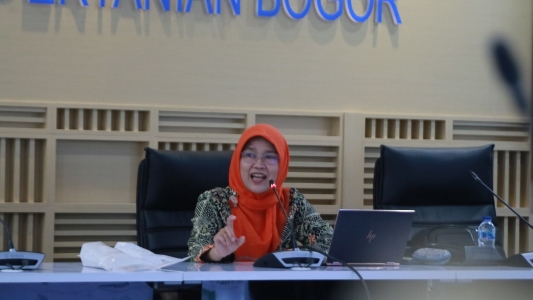Prof Evy Damayanti Reveals the Advantages of Kimpul talas

IPB University and De Talas, talas flour industry, present a nutritionist to explain the advantages and nutritional content of talas kimpul for food diversification. In a press conference held in the Academic Senate Meeting Room, Dramaga Campus IPB, Bogor (13/3), Prof Evy Damayanthi, lecturer at the Nutrition Sciences Department of IPB University said that talas kimpul deserves to be a staple food to support Indonesia's food security.
"Talas kimpul/belitung is a food source of carbohydrates, low in fat and has a low glycemic index. Kimpul talas also contains nutrients that are beneficial to health. It contains dietary fiber, resistant starch, copper and potassium minerals, vitamin B3 and the bioactive components of diogenin and flavonoids," she explained.
According to her, dietary fiber is good for the digestive organs. When compared to Bogor talas, gembili and cassava, talas kimpul has a high carbohydrate content, low fat, low calories, easy to digest and gluten free.
“Talas kimpul can be considered as a suitable raw material for obtaining type III resistant starch (RS3). Resistant starch is good for health because it prevents cardiovascular disease, colon cancer, diabetes, obesity and osteoporosis. Resistant starch also nourishes the intestines, facilitates the absorption of micronutrients and thus increases the number of probiotic microorganisms in the body," explained the Professor of Nutrition Science at IPB University.
Meanwhile, she continued, talas kimpul also has bioactive components such as alkaloids, flavonoids, saponins, tannins, steroids, diosgenin to phenols. Diosgenin is good for beauty because it maintains skin health (anti-aging).
"So far, talas kimpul is only processed by boiling and frying, even though talas kimpul can be made into flour which is then processed into cookies, plain bread, dry noodles, sagon dry noodles instead of kimpul, wet noodles, meatballs, brownies, food thickening agents," added the Chairman of the IPB University Professorship Council (DGB).
With this variety of preparations, she added, talas has the potential to become a food ingredient that can support Indonesia's food security. "In recent years, DGB IPB University has been very active in supporting sago as a source of carbohydrates for Indonesia's food security. talas kimpul is one of Indonesia's wealth, it can grow under forest stands but can also be cultivated. We've tried it (processed talas kimpul) and it's really, really worth it. With efforts to become flour, its use is wider. I think organoleptically it is very feasible and from a health point of view it is also very good.
In this activity, it was revealed that currently there is already a talas flour industry in the Mount Rinjani area, Lombok. "Lombok, under Mount Rinjani, is endemic to talas kimpul. There is no market there yet. So we are trying to create a market by cooperating with dozens of farmer groups and 2,500 farmers," said Boyke, owner of De Talas.
He explained that the raw material for talas kimpul was chosen because the plant is tolerant and has minimal disease. Potentially, 1 hectare of forest land can be planted with 4,000 trees or 12 tons of talas (without special maintenance). "So per hectare you can get three tons of flour. Speaking of food security, talas kimpul can efficiently substitute wheat flour," he said. (Zul) (IAAS/Res)



